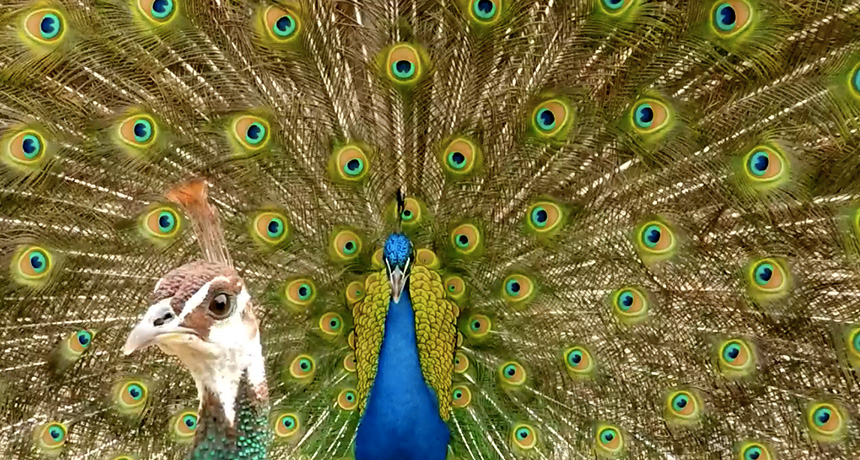Male peacocks twerk it to bring in the hens
As the guys gyrate, the eyespots on their feathers stay still

Researchers watched high-speed video of peacock mating displays. They found that the male vibrates his feathers in sync and at a high frequency.
R. Dakin
Share this:
- Share via email (Opens in new window) Email
- Click to share on Facebook (Opens in new window) Facebook
- Click to share on X (Opens in new window) X
- Click to share on Pinterest (Opens in new window) Pinterest
- Click to share on Reddit (Opens in new window) Reddit
- Share to Google Classroom (Opens in new window) Google Classroom
- Click to print (Opens in new window) Print
Male peacocks know how to twerk it to attract peahens.
During mating season, the flamboyant males really put on a show. Each will raise his iridescent train, shake his wings and vibrate his fan. Such displays can go on for hours.
A group of researchers wanted to break down the basic biomechanics of this shimmy show. It is known as “rattling.” The team included Roslyn Dakin. She is at biologist at the University of British Columbia in Vancouver, Canada. Physicist Suzanne Kane was also part of the group. She works at Haverford College in Pennsylvania.
The team also studied a related peacock move called “shivering,” which occurs before females arrive. This is a reshuffling of feathers akin to a dandy combing his hair.
The researchers recorded peafowl (Pavo cristatus) in action using a high-speed video camera. They also studied feathers in the lab. Rattling birds shake their shorter, stiff tail feathers to strum their fanned-out train. That makes the fan feathers vibrate at the same high frequency (25.6 hertz on average). This frequency sweet spot generates a loud rustling noise — also part of the show. The team reported its findings April 27 in PLOS ONE.
The scientists saw variety from bird to bird. But individual peacocks tended to vibrate their feathers at a consistent frequency. Males with longer trains vibrated at slightly higher frequencies than those with shorter ones. Shivering involved lower-frequency feather vibrations than rattling.
Despite all this gyration, the eyespots at the ends of the fan’s feathers stay still. That is due to tiny hooks that lock the eyespot barbs together. “It isn’t just beautiful,” Kane explains. “It acts like a single mass at the top of the feather.”
Previous studies have shown that males with more iridescent eyespots have more success with the ladies. High-frequency shimmying might be indicative of a male’s health or muscle power, Dakin says. But how the female perceives the total package remains unstudied. “One has to wonder what it’s like to be a female seeing this for the first time,” she says.
Power Words
(for more about Power Words, click here)
biology The study of living things. The scientists who study them are known as biologists.
biomechanics The study of how living things move, especially of the forces exerted by muscles and gravity on the skeletal structure.
frequency The number of times a specified periodic phenomenon occurs within a specified time interval. (In physics) The number of wavelengths that occurs over a particular interval of time.
gyration A quick rapid circular, spiraling or whirling motion.
hertz The frequency with which something (such as a wavelength) occurs, measured in the number of times the cycle repeats during each second of time.
iridescent Adjective that describes something that seems to change color with a shift in the angle at which it is viewed or at which lighting is applied.
peafowl The generic term for peacocks (males) and peahens (females).
physics The scientific study of the nature and properties of matter and energy. Classical physics is an explanation of the nature and properties of matter and energy that relies on descriptions such as Newton’s laws of motion. Quantum physics, a field of study which emerged later, is a more accurate way of explaining the motions and behavior of matter. A scientist who works in that field is known as a physicist.







